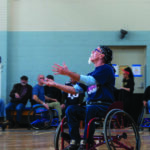Home // SCI/D Resources // Spinal Cord Injury & Disease (SCI/D)
A Word About Spinal Cord Injury and Diseases
A spinal cord injury (S.C.I.) is caused by trauma to the spinal cord, most often resulting in paralysis, a loss of sensation and control of bodily function below the point of injury.
Facts and Figures
Each year there are approximately 10,000 people who sustain a spinal cord injury. It is estimated that there are now over 300,000 Americans who have experienced and are living with a spinal cord injury. After automobile accidents, the leading causes of spinal cord injury are recreational activities and falls.
A Description of the Spinal Cord
The human spinal cord is a bundle of nerve cells and fibers approximately 17 inches long which extends from the brain to the lower back. The spinal cord carries messages from the brain to all parts of the body – to the body’s muscles, internal organs and skin, and back again.
There are different levels of spinal cord injury. Generally the higher the level of the injury, the greater the disability. For example, an injury to the spine in the cervical area (neck) may cause paralysis in the arms and legs and result in “Quadriplegia” while a lower injury-such as in the thoracic area (chest)-may affect the legs and lower part of the body and result in “Paraplegia”. The level at which the spinal cord is damaged will determine the type of movement and sensation retained by a person as a result of a spinal cord injury.
The Past
Before 1940, so little was known about treating someone with a spinal cord injury that most paraplegics/quadriplegics died within one year of their injury. It was not until the mid-1940’s that people began to survive the trauma of paralysis. This survival was made possible through the utilization of newly discovered antibiotics, which reduced the often fatal complications associated with spinal cord injury. Additionally, Veterans Administration Hospitals serving SCI veterans returning from W.W.II were developing surgical and rehabilitative medical skills that helped to increase the chances of survival and lengthen the life expectancy of most paraplegics. It was during these years that the paralyzed individual, once a medical oddity, became a common sight in hospitals.
The Present
Today, the life expectancy of a spinal cord injured person is about the same as an able bodied individual, thanks to on-going advancements in SCI medical research, rehabilitation and treatments.
Naturally, special support services are needed by paralyzed individuals to live their lives as fully as possible. The sudden impact of spinal cord injury affects an individual in many ways. In addition to the physical changes which take place, there are also social and emotional considerations for the person who is injured, as well as, for family members and friends.
Rehabilitation, education, job training, procurement of prosthetic devices, accessible housing and financial assistance must be available to enable a person with a spinal cord injury to live a productive and independent life.
The Future
The cure for spinal cord injury still remains elusive, even though scientists across the country are performing research in areas of regeneration.
Discovery of a way to prevent paralysis following traumatic injury or to cure chronic paralysis remains a sincere hope for all who have, in some way, been affected by this disability. Toward that end, we enthusiastically support all research that will cure or enhance the life of a paralyzed person.



